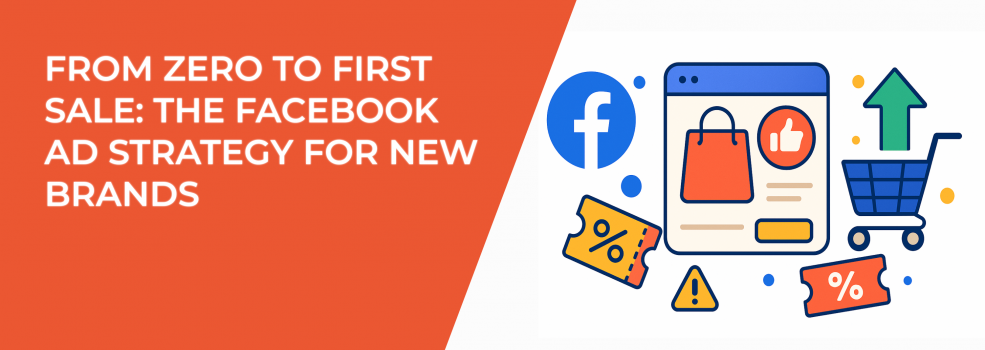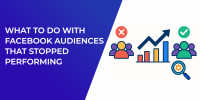You’ve built your product. Maybe even your website. Now comes the hard part — making your first sale using Facebook ads.
But where do you start?
For new brands, launching a Facebook ads strategy can feel like navigating a maze blindfolded. The platform is powerful, but it's also complex, full of features that overwhelm even experienced advertisers.
Still, thousands of small businesses find their first customers here every day. The difference? They follow a strategy that prioritizes data, creative, and consistency over guesswork and hype.
In this guide, you'll learn how to move from zero to that first sale using Facebook and Instagram ads step by step.
Step 1: Set the Foundation Before Spending a Dime
Before you launch any Facebook advertising campaign, make sure your digital storefront is ready to convert. A great Facebook ad can only do so much — your website or landing page must carry the rest of the weight.
Ask yourself:
-
Is your site mobile-friendly and fast to load?
-
Are your product images professional, clear, and compelling?
-
Does your homepage or product page communicate value within the first few seconds?
If the answer to any of these is “no,” fix that first. Otherwise, your ad dollars will disappear fast with little to show for it.
Also, invest time in organic content. Your Facebook or Instagram page doesn’t need thousands of followers, but it should show signs of life. Post consistently and authentically, showcasing your product in action and the story behind your brand.
Pro tip: boost a strong organic post for $10–$20. This is an easy way to test content and see what resonates before running full campaigns.
Step 2: Start With a Hypothesis, Then Let the Data Lead
Most new brands start with assumptions about who their customer is. That’s a good starting point — but don’t get too attached.
Facebook Ads targeting has changed. As we explained in our guide to Facebook Ads targeting updates in 2025, Meta now relies more on machine learning than on manual audience selections. Interest-based targeting still exists, but the algorithm increasingly favors broad targeting with strong creative signals.
When setting up your first campaign:
-
Keep targeting simple. Use just age, gender, and location filters based on your assumptions.
-
Avoid stacking too many interests. Let Facebook’s algorithm explore and find high-performing pockets.
-
Use only 1–2 ad sets to start. This keeps your budget concentrated and results clearer.
If you're unsure how to narrow down your ideal customer group, this step-by-step guide on defining a target audience for marketing can help you clarify and prioritize who to target first.
Then, watch the data and monitor:
-
Click-through rate (CTR): are people engaging with your ads?
-
Cost per click (CPC): are you getting cheap traffic?
-
Demographics breakdown: who’s clicking? Who’s converting?
If your best engagement is coming from 45+ women, but you thought your product was for Gen Z? Adjust accordingly. Data > gut feeling.
Step 3: Let Creatives Do the Selling
You can target the perfect person, but if your ad doesn’t grab their attention, it won’t matter.
Creative is the #1 driver of success for new Facebook Ads campaigns. That means your visuals, copy, and format all need to work together to stop the scroll.
When designing your first ads:
-
Use real, relatable visuals. Product demos, lifestyle images, or unpolished user-generated content often outperform polished studio shots.
-
Include motion. Even subtle animations or video clips boost engagement.
-
Lead with benefits. Instead of “Buy Now,” try “Struggling with X? Here’s a better way.”
Different ad formats and types of ad content can have different engagement and conversion rates, which makes testing essential.
Try testing different creative formats such as:
-
Short demo videos (under 15 seconds),
-
Before-and-after visuals,
-
Carousel ads highlighting key features,
-
Testimonials or quotes from early users.
Don’t launch all at once. Test one creative at a time so you know what’s really working.
And remember: the goal isn’t to explain everything. It’s to create just enough curiosity for someone to click.
Step 4: Budget Smartly and Learn Before Scaling
You don’t need a massive budget to get your first sale. But you do need to spend it wisely.
Think of your early ad budget as market research — not just marketing.
Here’s how to start:
-
Use Advantage Campaign Budget (CBO) with 1–2 ad sets.
-
Start with $10–$20 per day. This is enough to test without wasting money.
-
Run campaigns for 3–5 days before making changes. Give Facebook time to optimize.
After that, pause poor performers and build on what’s working. Look beyond purchases. Metrics like:
-
Add-to-cart rate,
-
Landing page view cost,
-
Drop-off rate at checkout,
will tell you if the problem is the ad, the product, or the buying process.
Quick test: if your CTR is high, but conversions are low — your ad is great, but your site needs work.
If you're seeing delivery issues or low impressions early on, here's why you might see “Ad Set May Get Zero” and how to fix it before wasting budget.
Step 5: Retarget Like a Human
Very few people buy the first time they see an ad. That’s where retargeting comes in.
But don’t just blast people with the same message over and over. That’s annoying — and it doesn’t convert.
Set up custom audiences based on:
-
People who visited your product page,
-
Those who added to cart but didn’t purchase,
-
Instagram or Facebook post engagers.
Then, create different ads that build trust:
-
Customer testimonials,
-
A behind-the-scenes look at your brand,
-
Limited-time offer reminders.
And watch frequency. If someone sees your ad 8+ times and still hasn’t clicked, stop wasting budget and move on.
Need help setting up your retargeting audiences? Here's a clear walkthrough on how to set up Facebook retargeting the right way.
Step 6: Maximize Your First Sale
That first sale means everything. Not just for revenue — for momentum.
Once someone buys, follow up quickly:
-
Send a thank-you message,
-
Ask for a review or feedback,
-
Offer a referral discount.
Even better, ask for a short video or image of the product in use. Use that as creative in your next campaign — user-generated content is some of the most effective advertising you can run.
And don’t stop testing. Keep experimenting with audiences, creative formats, and messaging. The Facebook ads algorithm improves with each campaign you launch.
Consistency beats perfection.
Final Thoughts
Running Facebook Ads for a new brand is not easy, but it is doable. Follow a clear strategy:
-
Build your brand’s foundation first.
-
Start with small, smart tests.
-
Let the data guide your decisions.
-
Focus on scroll-stopping creative.
-
Retarget with empathy, not pressure.
-
Use your first sale to fuel your next ten.
Ready to make your first sale? Then it’s time to get your strategy off the whiteboard and into Ads Manager.

